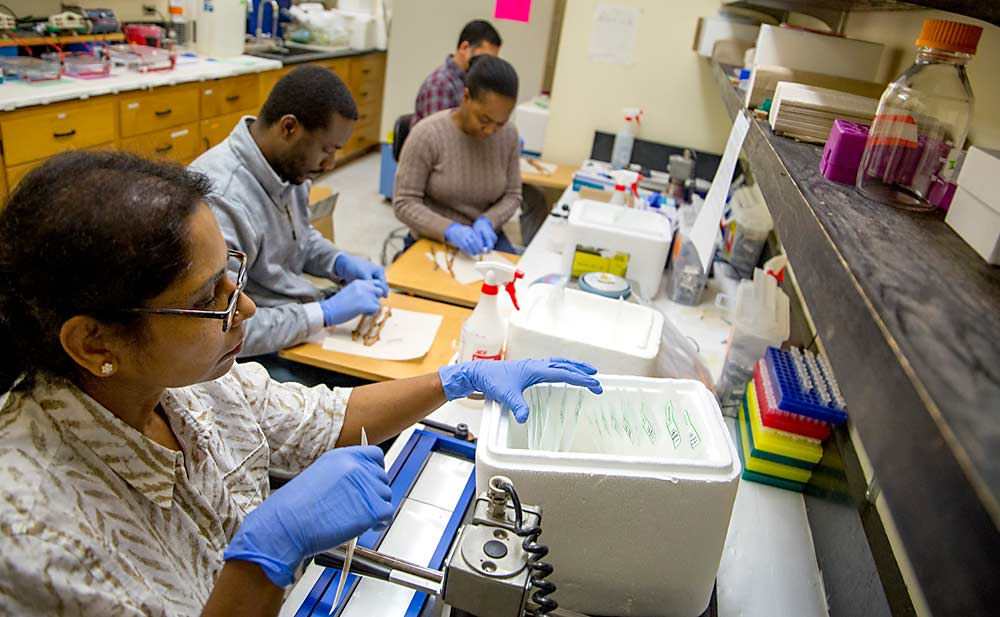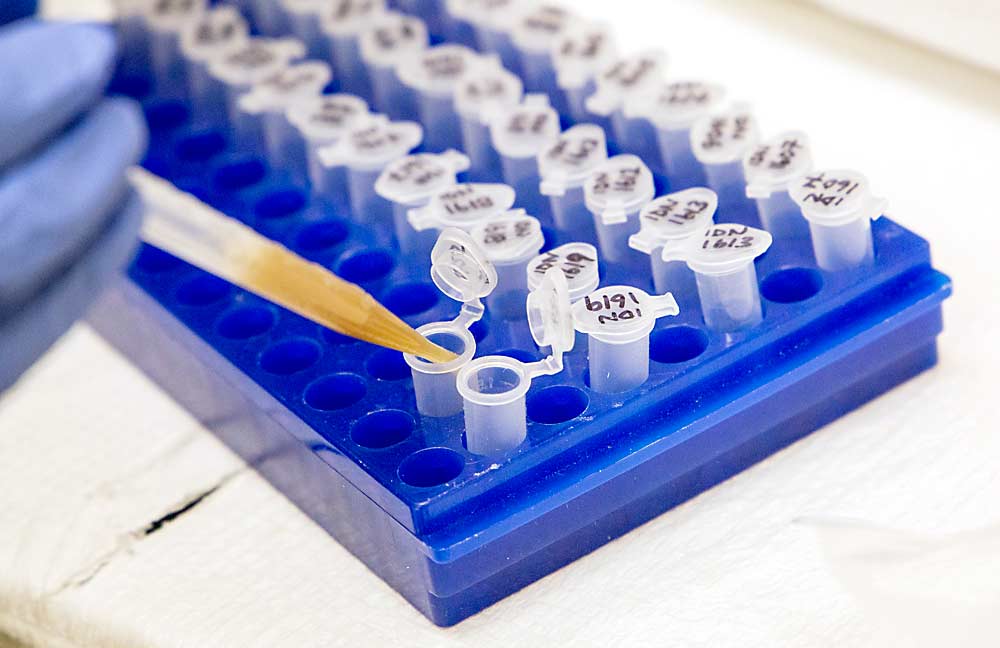
Washington State University virologist Naidu Rayapati has been screening vineyard samples for viruses in his laboratory for about 15 years. He wants growers to keep those samples coming.
As grapevine red blotch and grapevine leafroll become more prevalent, as pest pressures force grape growers to replant and shift to rootstocks, and as an oversupply gives the industry time to pause, Washington wine grape producers may be entering a new era of virus testing.
Rayapati thinks growers throughout the industry need to test more often, but they may find cost a hurdle. So, he is offering to test samples for free, for as long as he can, and follow up the results with advice and questions for growers that would also fit within his ongoing research about the viruses, funded by the Washington State Wine Commission.
“I would like to see more growers use us” and take advantage of that expertise, said Rayapati, also director of WSU’s Irrigated Agriculture Research and Extension Center in Prosser.
Meanwhile, his lab may reduce the pressure on the Clean Plant Center Northwest, also located at the Prosser station. The Clean Plant Center charges for screening for the two grape viruses, but it has been inundated with diagnosing pathogens associated with little cherry disease. Also, commercial laboratories in Washington have begun offering screening services for grape pathogens, including leafroll and red blotch.
Melissa Hansen, research program director for the Wine Commission, agrees the industry needs to test more often and earlier. The sooner growers confirm a virus, the sooner they can rogue out the infected vine.
“Growers, you need to step up your testing, whether it be WSU or commercial testing,” she said.
Rayapati also wants growers to hear the latest information on leafroll and red blotch, the two most economically important vineyard viruses. The two often produce similar symptoms, reducing vine health, yields and fruit quality over time, but they present different management concerns.
Leafroll is prevalent in Washington and is vectored by mealybugs and soft scale insects. Rayapati recommends roguing out infected vines and taking measures to control the vectors. But if growers are not aggressive, it can spread rapidly. In California, the U.S. Department of Agriculture Farm Service Agency has approved leafroll for natural disaster coverage.
Red blotch occurs at a much lower rate than leafroll and does not seem to spread vine-to-vine because there is no known vector in Washington. Roguing out infected vines should be enough to clean up the problem that stemmed from infected planting or grafting stock.
“Roguing can really help to eliminate red blotch in an infected block,” Rayapati told growers at a February workshop organized by the Washington State Wine Commission.

In California, researchers have reported the three-cornered alfalfa tree hopper is vectoring the disease, though the pest has not yet been found in Washington, said Doug Walsh, an entomologist at the Prosser research station.
Meanwhile, the two viruses don’t affect all grapes the same way.
Concords and white grapes typically don’t show symptoms, but they still could be infected. Also, mechanical damage, crown gall, winter damage, nutrient deficiencies and mites can cause similar visual effects, thereby complicating visual diagnoses of viral infections.
And, symptoms don’t always show up the same throughout the year. For example, they don’t usually appear before veraison, so infected vines could look healthy. However, Rayapati’s testing, which uses a DNA amplification technique called polymerase chain reaction assays, can detect the viruses year-round, regardless of symptoms.
As more growers ask for tests, Rayapati’s laboratory may have to start charging some fees to boost its capacity. He estimates the cost would run about $15 per sample for both viruses, he said. And, as part of the land-grant university mission, he aims to communicate with growers after test results to offer recommendations and seek feedback about management practices. He usually recommends removing at least one vine on either side of the symptomatic vine.
A new era
Ste. Michelle Wine Estates sends about 300 to 350 samples per year through Rayapati’s lab, said Kevin Corliss, vice president of vineyards. Some are from mother blocks, which they use to propagate their own new vineyards. Some are targeted to diagnose noticeable problems, such as low yield or poor fruit quality. Some are simply helping Rayapati with his research. The company also sends samples to commercial laboratories.
The company does not necessarily require routine virus screening for contracts, but they take it into account when setting the terms, Corliss said.
Corliss encourages growers to start their own mother blocks, test them vigorously and use those for their new plantings. However, when it comes to leafroll, planting clean may no longer be enough to stay clean, Corliss said. Infected but asymptomatic vines nearby can easily infect newly planted blocks.
“It’s one of those hard questions that, as an industry, we need to go down that road at some point,” he said.
Rick Hamman, a Benton City viticulture consultant, also encourages growers to view their orchard as part of a wider landscape, not just infected block by infected block. Leafroll reinfection rates are surprisingly fast. He has seen newly planted blocks go from clean planting stock to 90 percent infected within five years of replanting.
“Just planting clean stock does not mean you’re not going to get (viruses),” said Hamman, the former vineyard manager for Hogue Cellars in Prosser.
Hamman also is glad Rayapati is reminding growers to test. Visual symptoms can be deceiving. He has sent in samples from blocks he was certain had leafroll virus, only to receive negative test results.
“You can’t overemphasize the importance of testing,” he said.
—by Ross Courtney
Related:
—Vineyard health check draws a crowd
—Good to Know: Another big year for grape and wine research
—Sugar stall caused by grapevine red blotch virus
—Rational mealybug management recommended






Leave A Comment